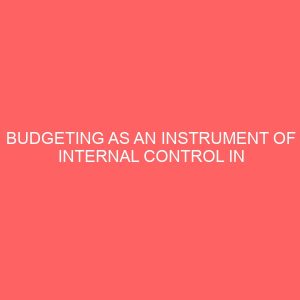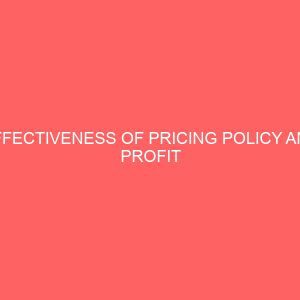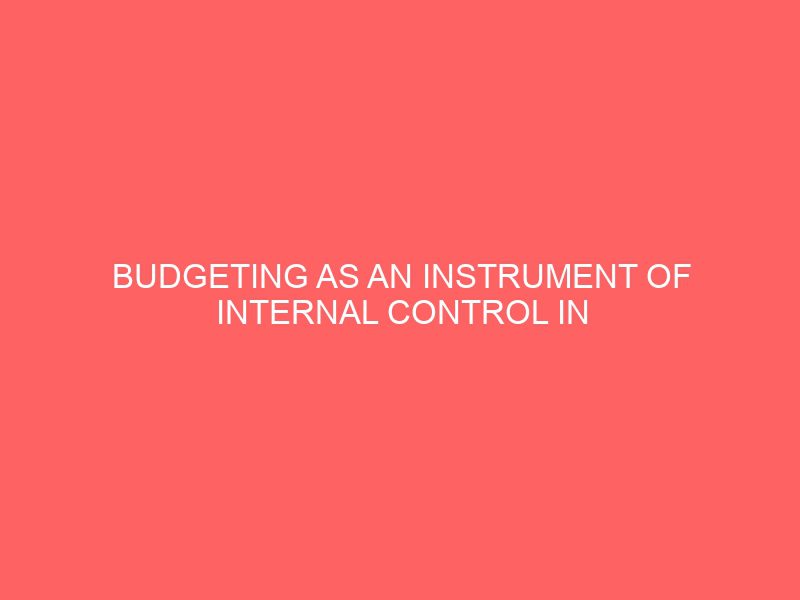Description
CHAPTER ONE
INTRODUCTION
BACKGROUND OF THE STUDY
According to Enudu (1999), the business environment is characterized by a lot of uncertainties ranging from such factors as: Economic environment, political and legal factors, social environment, supply and demand forces, competition, consumers’ attitude and technological changes.
A critical look at the performances of some of these manufacturing business organizations will reveal a lot of business failures as a result of lack of proper planning against these uncertainties.
According to Drury (2000), proper planning of business helps in reducing uncertainties thereby providing the management of these enterprises with a clear direction by determining their courses of actions in advance.
According to Pandey (2010), for any enterprise to achieve these goals and objectives, they must be managed effectively and efficiently. Management is efficient if it is able to accomplish the objectives of the enterprise and becomes effective when it accomplishes the objectives with minimum efforts and costs. One of the ways in which the management can achieve these objectives is though profit planning and control or budgeting.
According to Nweze (2011), Budgeting in its true word is the design of the future state of an entity and the effective ways of bringing it about. Budgeting or planning involves the determination of the future course of actions for accomplishing the objectives of the enterprise.
According to Lucey (2002), the main purpose of budget planning is to provide the necessary guidelines for making decisions. With the proper budget planning, the enterprise can no longer be under the mercy of whims of Fickle economic and social forces thereby relying on the ability to sense what is required. (Nweze 2011).
The value of budgeting control of any organization can never be over- emphasized as these organizations and companies have limited resources and these scarce resources impose limits on the number of extent and range of end result the organization was set out to achieve.
According to Nwoha and Ekwe (1999), some of these goals include maximizing profit or achieving some satisfactory level of performance, profit satisfaction achieving continual growth or ensuring the survival of the organization avoiding risk in making investment and performing a social services desired by others.
According to Nweze (2011), A budget therefore co-ordinates the separate plans of different departments in an organization be it manufacturing concerns or non-manufacturing concerns and provides means of bringing both the marketing, production and financial activities of the organization together.
STATEMENT OF THE PROBLEM
Having stated earlier according to Enudu (1999) that the business environment is full of uncertainties as a result of such factors; socio-economic issues, political unrest, demand and supply forces, legal issues and technological changes all these affect the management of any organization in one way or the other thus needed attention for proper management. You would equally recalled that organizational goals and objectives are numerous but the means or resources for satisfying these needs are limited, at times not available hence needed control to satisfy the high priority areas.
These problems enunciated above have led the researcher to find answers to such questions as follows:-
- Do manufacturing companies in Nigeria do Budgeting?
- If they do, what are the types of budgeting usually employed by them?
- The type used or applied does it enhances their profit planning strategies?
OBJECTIVES OF THE STUDY
According to Pandey (2010), Budgeting was undertaking with the following objectives in mind.
- To find out whether or not manufacturing business organizations control their levels of profit making and the means used to achieve
- To examine whether the manufacturing business concerns in Nigeria plans their profits hence their losses are unnecessarily large in relation to their budget estimate
- To identify the types of budgeting in some of the manufacturing business concern in Nigeria that enhance efficiency
RESEARCH QUESTIONS
- Does the manufacturing business organization control their levels of profit making and the means used to achieve it ?
- Does manufacturing business concerns in Nigeria plans their profit hence their losses are unnecessarily large in relation to their budget estimate ?
- Does the types of budgeting in some of the manufacturing business concern in Nigeria enhance efficiency ?
HYPOTHESES OF THE STUDY
To identify the achievements of the desired objectives, the following hypotheses are formulated:
H0: Represents Null Hypothesis
H1: Represents Alternate Hypothesis
HYPOTHESIS I
H0: Manufacturing business organization do not control their levels of profit making and the means used to achieve it.
H1: Manufacturing business organization do control their levels of profit making and the means used to achieve it.
HYPOTHESIS II
H0: Manufacturing business concerns in Nigeria do not plan their profit hence their losses are unnecessarily large in relation to their budget estimate.
H1: Manufacturing business concerns in Nigeria do plan their profit hence their amount of losses are not unnecessarily large in relation to their budget estimate.
HYPOTHESIS III
H0: The type of budgeting in some of the manufacturing business concern in Nigeria is not efficient.
H1: The type of budgeting in some of the manufacturing business concern in Nigeria is efficient.
SIGNIFICANCE OF THE STUDY
According to Nweze (2011), Budgeting is very important especially at this time of our economic development at this time of our economic development is that.
It will show why profit planning is very vital for any manufacturing establishment that wishes to survive.
It will help them to determine and maintain an acceptable level between high profit and low profit at a given time thus leading them to attain the various organizational goals and objectives.
SCOPE OF THE STUDY
Due to the cost effectiveness of this research and time, this research has being conducted in Nigerian Breweries Onitsha, Anambra state.
LIMITATIONS OF THE STUDY
As a result of these constraints (time and money) this study was limited to Nigerian’s famous brewery in Anambra State, Nigerian Breweries Onitsha in Anambra state.
Another limiting factor was the literacy level of the respondents. Out of 78 respondents sample their opinions, 2 of them were sceptical as regards given out useful information on the budget planning of this organization. This was a result of dishing out useful data to their competitors in the same manufacturing industries or business.
DEFINITION OF TERMS
EFFICIENT: A firm is said to be efficient if it can manage their resources well
EFFECTIVENESS: This entails proper co-ordination of these limited resources in form of both human and material resources to combat their responsibilities
PLANNING: The design of a desired future state of an entity and the effective ways of brings it about.
GOALS: Performances can be defined as the assessment of the company towards reaching the targeted goals and objectives.








Reviews
There are no reviews yet.